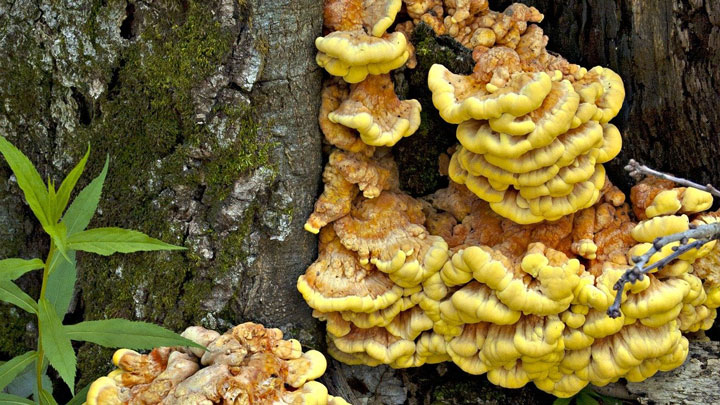
Have you heard of Chicken of the Woods? No, it’s not a dove, or even a turkey—it’s yet another vibrant, easily identifiable mushroom that will make a delicious addition to your table. Read on for how to identify this mushroom, as well as some great ways to prepare it.
This large polypore is easy to spot. It’s large, generally prominently placed, and radiant orange in color. The name is partially derived from its zesty, meaty taste, and partially from its commonality. Some folks describe its taste as exactly akin to chicken, others reckon it’s more like crab. Just depends on how your taste buds are structured, I guess. Another thing to note, its not just taste that varies. Chicken of the Woods can cause gastric distress in some folks, so just try a little your first time, to avoid a possible visit to the bathroom.
Identification
If you’re wondering why I called it a polypore, its because this mushroom disperses spores through small pores under their caps. Not really relevant to anyone but the scientists, but a fun fact I think bears repeating. As these are parasitic mushrooms, you can most often find them feeding either on already dead trees, or on live ones they are rotting the wood of, generally at the base. In addition to their color, you can easily recognize these mushrooms from their overlapping layers. The older and larger the mushroom the more that orange fades by the way, so don’t be put off if it looks faded. That just means you’ve stumbled on an older, probably quite large sample. One easy identifier is the lack of a stem on any of these mushrooms, hence the tightly overlapping layers. The layers are fan shaped, and range from completely smooth to lightly wrinkled. Cut open, the inside color should match the outside. Underneath, the caps sport white-yellow pores, instead of the more common mushroom gills.
Varieties
There are 12 species in North America. The three most common are the Laetiporus Cincinnatus, usually found in the east, the Laetiporus Conifericols, usually found in the West, and the Laetiporus Gilbersonii, only found on oaks and eucalyptus trees in the West. The first mentioned will have a slightly more reddish hue, while the second veers more toward yellow. Avoid any of the last, growing on oaks or eucalypti, as they are the most likely to cause the aforementioned gastric distress. All these mushrooms grow more prominently in late-summer through fall. While that is area dependent, figure August to October as a general rule of thumb.
Preparation Tips
To cook the Chicken of the Woods, start with a young, freshly picked specimen. They tend to become brittle with age. One indicator is a clear ooze, which young ones emit when you slice them. Wipe them with a damp cloth to clean, and refrigerate them no longer than a week. As these are quite large, cut them into small pieces to cook. They can be sautéed, baked or fried, depending on your taste. If you’ve cooked too many, the mushrooms will survive your freezer (once cooked), so don’t be afraid to save them for later.
These are the basics, which should go a long way to getting you started with Chicken of the Woods. Check back later for some great recipes you can use on this fantastic mushroom. Its a little late in the season, but I’m sure there are still a few in your area, particularly if you live further south. If not, there’s always next season. Until then, good luck, and happy foraging!
A humble homesteader based in an undisclosed location, Lars Drecker splits his time between tending his little slice of self-sustaining heaven, and bothering his neighbors to do his work for him. This is mainly the fault of a debilitating predilection for fishing, hunting, camping and all other things outdoors. When not engaged in any of the above activities, you can normally find him broken down on the side of the road, in some piece of junk he just “fixed-up.”

Douglas Balko says
Likely the best “shroom” I have EVER picked/cooked!
Gregory Burge says
This new found food source is Dynamic. It allows expanded copious amounts of food. Today’s society is not far from returning to our great grandfather’s way of life and putting food on the table. Sounds much more healthier to boot.
ernie says
I had some of tkat, and ended up in the White House.
frog says
Joe hasn’t gotten there yet
Bruce Clark says
No thanks.
Steve says
A favorite for flavor, fried in butter. Frequently get attacked by small worms when older.
Linda Meranda says
Wow! Definitely give it a try